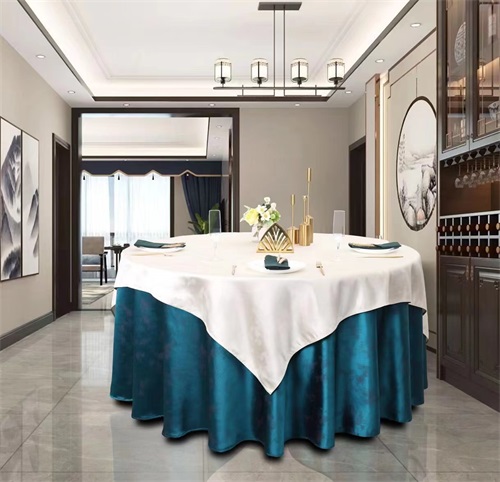酒店布草:酒店布草白度不夠怎么辦?
時(shí)間:2024-08-28 來源:http://www.caibozheng.cn/
大部分賓館、飯店的客房部使用的布草都是以白色為主,所以酒店人對(duì)客房布草的白度十分重視,如果只采用漂白,只能獲得一定的白度,但仔細(xì)觀察,你會(huì)發(fā)現(xiàn)布草上還會(huì)有淺黃色或褐色,這主要是織物本身對(duì)自然光線中的藍(lán)色光有微量的吸收,因此要使織物的白色達(dá)到一個(gè)理想的狀態(tài),可定期定量對(duì)布草實(shí)施增白。那么,白色布草怎么亮白如新呢?
Most hotels and restaurants use white as the main color for their guest room linens, so hotel staff attach great importance to the whiteness of guest room linens. If only bleaching is used, only a certain degree of whiteness can be obtained. However, upon careful observation, you will find that there will still be light yellow or brown on the linens. This is mainly due to the fabric itself absorbing a small amount of blue light from natural light. Therefore, to achieve an ideal whiteness of the fabric, regular and quantitative whitening of the linens can be carried out. So, how can white linen shine like new?

漂白的目的
The purpose of bleaching
在洗滌過程中的漂白目的主要有兩個(gè),一是去除織物上殘留的需經(jīng)過氧化作用或還原作用方可去除的污垢,使其達(dá)到織物本身的原有色澤;二是提升白色織物及帶顏色織物的白度和亮度,使其色澤更加明亮艷麗。
There are two main purposes of bleaching during the washing process. One is to remove the residual dirt on the fabric that needs to be removed through oxidation or reduction, so as to achieve the original color of the fabric itself; The second is to enhance the whiteness and brightness of white and colored fabrics, making their colors brighter and more vibrant.
洗滌過程中的織物(如毛巾、床單、臺(tái)布等)經(jīng)過沖洗、預(yù)洗和主洗流程,在程序加料合理的情況下,水溶性污垢、油溶性污垢和某些固體類污垢等一般情況都可以去除掉。但對(duì)一些色素類污垢,只能通過氧化和還原作用才能去除的特殊污垢,常規(guī)洗滌是無法徹底去除掉的,必須在洗滌過程中設(shè)置漂白程序方可達(dá)到污垢全部去除。
During the washing process, fabrics such as towels, bed sheets, tablecloths, etc. undergo washing, pre washing, and main washing processes. With reasonable program feeding, water-soluble dirt, oil soluble dirt, and certain solid dirt can generally be removed. However, for some pigment based dirt that can only be removed through oxidation and reduction, conventional washing cannot completely remove it. A bleaching program must be set up during the washing process to achieve complete removal of the dirt.
漂白的時(shí)間
Time for bleaching
漂白過程中時(shí)間的長短與漂白劑的釋放時(shí)間有關(guān)。在理想的漂白溫度和理想的洗液酸堿度(pH值10.5)中,漂白劑加料一分鐘時(shí)漂白劑基本已均勻的溶于洗液中。此時(shí)有效氯均勻的釋放,在6-8分鐘時(shí)氯基本釋放完畢,這時(shí)溶液中的有效氯的濃度在10ppm。在排水時(shí)有效氯的含量應(yīng)低于10ppm,所以在有效氯釋放完畢再延長漂白時(shí)間已不起作用。
The duration of the bleaching process is related to the release time of the bleaching agent. At the ideal bleaching temperature and ideal pH of the washing solution (pH 10.5), the bleaching agent is almost uniformly dissolved in the washing solution when added for one minute. At this point, the effective chlorine is released uniformly, and the chlorine is basically released within 6-8 minutes. At this point, the concentration of effective chlorine in the solution is 10ppm. The effective chlorine content during drainage should be less than 10ppm, so extending the bleaching time after the effective chlorine is released is no longer effective.
漂白的溫度
Bleaching temperature
在漂白過程中,溫度對(duì)漂白效果十分重要,在漂白程序中選用氧漂還是氯漂進(jìn)行漂白,可根據(jù)被漂白織物的特性及織物的顏色而選擇合理的運(yùn)用。
During the bleaching process, temperature is crucial for the bleaching effect. The choice between oxygen bleaching and chlorine bleaching in the bleaching process can be based on the characteristics and color of the bleached fabric.
漂白時(shí)溫度對(duì)于氯漂是十分重要的,提高漂液的溫度可提高漂白速度,縮短漂白時(shí)間。一般情況下漂白溫度增加10℃可縮短一倍的漂白時(shí)間,如使用氯漂劑漂白,漂白的溫度一般選擇在65℃以下否則會(huì)使織物污黃、牢度下降。如使用氧漂劑可選擇70℃~90℃為好。
The temperature during bleaching is very important for chlorine bleaching. Increasing the temperature of the bleaching solution can improve the bleaching speed and shorten the bleaching time. In general, increasing the bleaching temperature by 10 ℃ can shorten the bleaching time by twice. If chlorine bleach is used for bleaching, the bleaching temperature is generally chosen below 65 ℃, otherwise it will cause the fabric to become dirty and yellow, and the fastness will decrease. If using oxygen bleach, it is better to choose 70 ℃ to 90 ℃.
漂白的PH值
The pH value of bleaching
漂浴的pH值對(duì)于織物牢度損傷影響較大,當(dāng)漂浴的pH值為中性7時(shí),對(duì)織物損壞較重。漂浴在酸性條件下漂白速度十分快,但對(duì)纖維造成損傷較嚴(yán)重,正常情況下不建議采用。使用氯漂最佳狀態(tài)pH值是10.2-10.5左右,在這種情況下漂白速度一般,但對(duì)纖維損傷較小,一般情況下可將主洗與漂洗設(shè)計(jì)在同時(shí)進(jìn)行,既保持pH值又可達(dá)到漂白效果。
The pH value of the float bath has a significant impact on fabric fastness damage. When the pH value of the float bath is neutral at 7, the damage to the fabric is more severe. Under acidic conditions, the bleaching speed of the bleaching bath is very fast, but it can cause serious damage to the fibers, and it is not recommended to use it under normal circumstances. The optimal pH value for using chlorine bleaching is around 10.2-10.5. In this case, the bleaching speed is average, but the damage to the fibers is minimal. Generally, the main washing and rinsing can be designed to be carried out simultaneously to maintain the pH value and achieve the bleaching effect.
本文由酒店布草友情奉獻(xiàn).更多有關(guān)的知識(shí)請(qǐng)點(diǎn)擊:http://www.caibozheng.cn/真誠的態(tài)度.為您提供為全面的服務(wù).更多有關(guān)的知識(shí)我們將會(huì)陸續(xù)向大家奉獻(xiàn).敬請(qǐng)期待.
This article is a friendly contribution from the hotel linen. For more related knowledge, please click: http://www.caibozheng.cn/ Sincere attitude. We provide you with comprehensive services. We will gradually contribute more relevant knowledge to everyone. Please stay tuned
資訊推薦Information
聯(lián)系我們Information
